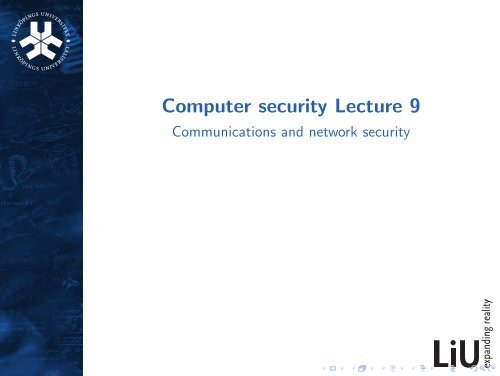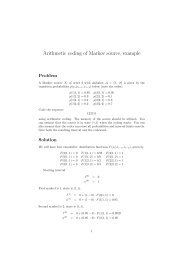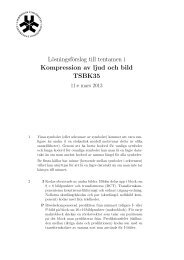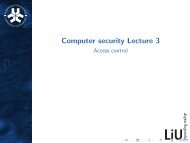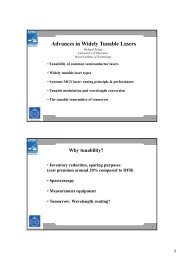Computer security Lecture 9 - Communications and network security
Computer security Lecture 9 - Communications and network security
Computer security Lecture 9 - Communications and network security
Create successful ePaper yourself
Turn your PDF publications into a flip-book with our unique Google optimized e-Paper software.
<strong>Computer</strong> <strong>security</strong> <strong>Lecture</strong> 9<strong>Communications</strong> <strong>and</strong> <strong>network</strong> <strong>security</strong>
Communication <strong>and</strong> <strong>network</strong> <strong>security</strong>: Threatmodel◮ Passive attacks: Eavesdropping, Wiretapping, Sniffing, <strong>and</strong>Traffic analysisAliceBobEve
Communication <strong>security</strong>: Secure tunnels◮ Typically provide Confidentiality, data Integrity, <strong>and</strong> dataorigin authentication◮ End points may be machines or services on the localcomputerAliceBobEve
Communication <strong>security</strong>: Secure tunnels◮ Typically provide Confidentiality, data Integrity, <strong>and</strong> dataorigin authentication◮ End points may be machines or services on the localcomputer◮ The placement is important to achieve <strong>security</strong>AliceBobEve
Communication <strong>security</strong>: Secure tunnelsSteps to set up a tunnel1. Authenticated key establishment (→asymmetric key)2. Key derivation (→symmetric key)3. Traffic protection through symmetric cryptographyAliceBobEve
Layered model of <strong>network</strong> protocols◮ The abstraction of <strong>network</strong> structure,the ISO/OSI seven-layer model◮ Security services at the top can betailored for specific applications, buteach application then needs a separateservice◮ Security services at the bottom canprotect the upper layers transparently,but may not meet all requirements ofspecific applicationsapplicationpresentationsessiontransport<strong>network</strong>linkphysical
Briefly on the layered modelconnection between peer entitiesat layer Nactual data exchangeN-PDUN-PDUheaderpayloadtrailerheaderpayloadtrailer(N − 1)-PDU(N − 1)-PDU
Briefly on the layered modelN-PDUN-PDUheaderpayloadtrailerheaderpayloadtrailer(N − 1)-PDU(N − 1)-PDUThere are two options for <strong>security</strong> services in the N − 1 layer◮ The upper layer can be aware of the <strong>security</strong> services at thelower layer◮ The lower layer <strong>security</strong> services can be transparent
The internet protocol stack◮ The application layer has Telnet, FTP,HTTP, SMTP, SET, . . .◮ The transport layer has the protocolsTCP <strong>and</strong> UDP, <strong>and</strong> applicationsconnect to ports in this layer◮ The internet layer has the IP protocol,nodes are identified through their IPaddress◮ The link (<strong>and</strong> the physical) layer arespecific to the tech usedapplicationtransportIP/Internetlink◮ There are <strong>security</strong> services both in thetransport <strong>and</strong> Internet layers
The IP protocol◮ The IP protocol is stateless <strong>and</strong> doesnot keep track of connections◮ Each packet is independent◮ No guaranteed delivery◮ Order is not preserved◮ No <strong>security</strong> mechanismapplicationtransportIP/Internetlink
IPsec, IP protocol <strong>security</strong>◮ Security architecture is in RFC 4301◮ Optional for IPv4, m<strong>and</strong>atory for IPv6◮ Two major <strong>security</strong> mechanisms:Authentication Header <strong>and</strong>Encapsulating Security Payload◮ Authentication Header does not giveConfidentiality; it was used to avoidexport restrictions in the 90sapplicationtransportIP/InternetIPseclink
IPsec, Encapsulating Security Payloads◮ ESP provides Confidentiality, dataIntegrity, data origin authentication,some replay protection, <strong>and</strong> limitedtraffic flow Confidentiality◮ ESP can be run in two modes:Transport mode <strong>and</strong> Tunnel mode◮ For transport mode, both nodes need tobe IPsec-aware◮ Tunnel mode, on the other h<strong>and</strong>, istransparent: IP-within-IPsecapplicationtransportIP/InternetIPseclink
IPsec, Encapsulating Security PayloadsTransport modeoriginalIP header(extendedheader)TCPDataoriginalIP headerroutingESPheader(dest.) TCP DataESPtrailerESPauth.encryptedauthenticatedTunnel modeoriginalIP header(orig extheaders)TCP Datanew IPheader(new extheaders)ESPheaderoriginalIP header(orig extheaders) TCP Data ESPtrailerencryptedauthenticatedESPauth.
IPsec, Encapsulating Security PayloadsTunnel modeoriginalIP header(orig extheaders)TCP Datanew IPheader(new extheaders)ESPheaderoriginalIP header(orig extheaders) TCP Data ESPtrailerencryptedauthenticatedESPauth.AliceBob
ESP headers, <strong>and</strong> Security Association◮ The ESP header contains the ID of a Security Association(SA), <strong>and</strong> a sequence number◮ The SA is a common state for communication from onenode to another (so IPsec is not stateless)◮ Usually created in pairs◮ State includes source, destination, <strong>security</strong> protocol,cryptographic algorithms <strong>and</strong> keys, key lifetimes, IVs,sequence numbers <strong>and</strong> anti-replay windows◮ SAs can be combined in multiple nesting levelsAliceBob
Establishing SAs through Internet KeyExchange (IKE, ISAKMP)◮ Internet Key Exchange (v2) is in RFC 4306◮ Uses two phases◮ First phase:◮ establishes a shared session key through Diffie-Hellman keyexchange◮ the result is an SA for IKE itselfTrentKey distribution centerK AT , K BTα a mod pK AB = (α b ) aAlice, a, K ATα b mod pBob, b, K BTK AB = (α a ) b
Establishing SAs through Internet KeyExchange (IKE, ISAKMP)◮ Internet Key Exchange (v2) is in RFC 4306◮ Uses two phases◮ First phase:◮ establishes a shared session key through Diffie-Hellman keyexchange◮ the result is an SA for IKE itself◮ to achieve authentication, a pre-shared secret or trustedpublic keys are neededTrentKey distribution centerK AT , K BTver B ?ver Bα a , E KAB (sig A (α a , α b ))ver Aver A ?K AB = (α b ) aAlice, a, K ATα b , E KAB (sig B (α a , α b ))Bob, b, K BTK AB = (α a ) b
Establishing SAs through Internet KeyExchange (IKE, ISAKMP)◮ Internet Key Exchange (v2) is in RFC 4306◮ Uses two phases◮ First phase:◮ establishes a shared session key through Diffie-Hellman keyexchange◮ the result is an SA for IKE itself◮ to achieve authentication, a pre-shared secret or trustedpublic keys are needed◮ Second phase establishes IPsec Security Association(s) inan encrypted session, that uses the key formed in the firstphaseAlice, a, K ATBob, b, K BT
IPsec problems: DOS◮ In the first phase, an attacker might send bogus responses◮ The second phase would never complete◮ The bogus keys will need storage◮ Mitigation: use several responses◮ Storing all responses for each connection will wasteresources◮ Solution: store them until negotiation completes◮ Use the resulting SA
IPsec problems: DOS II◮ Another DOS possibility is to flood a node with initiationrequests from forged IPs◮ This would make the node waste resources on calculatingresponses <strong>and</strong> storing session data◮ Solution to this is to do no state storage first, but respondwith a “cookie”, expecting it to return from the initiator IP◮ If the IP is bogus, the DOSer does not get the cookie, <strong>and</strong>cannot return it◮ Cookie format is not st<strong>and</strong>ardized, the RFC suggests tohash IP, the request nonce, <strong>and</strong> a local secret that ischanged regularly
IPsec <strong>and</strong> NAT◮ Network Address Translation was invented to cope with thelack of available IPv4 addresses◮ Nowadays it is sometimes seen as a <strong>security</strong> feature thatinternal IPs are not directly addressable◮ This creates problems, especially for IKE sinceauthentication is by IP address◮ NAT-T (“IPsec passthrough”) solves this by adding anextra header, triggering rewriting rules at the recipient afterpacket authenticity has been checked
Pros <strong>and</strong> cons of IPsec◮ IPsec provides <strong>security</strong> transparently◮ Upper layers need not be aware that lower layers are morecomplicated to provide <strong>security</strong>◮ Cannot be tuned for specific applications◮ IPsec provides host-to-host (gateway-to-gateway) <strong>security</strong>,not user-to-user or application-to-application <strong>security</strong>◮ IP is stateless <strong>and</strong> unreliable by construction, but IPsec isstateful◮ IPsec packets need to be ordered, while IP should not beconcerned with packet order or dropped packets
SSL/TLS◮ Placed between “normal” TCP <strong>and</strong>application◮ H<strong>and</strong>shake phase uses asymmetricencryption <strong>and</strong> certificates to exchangethe session key◮ The server (but not the client) isauthenticated (by its certificate)◮ Session key is for a symmetric algorithm◮ Many different algorithms can be used,the set is not st<strong>and</strong>ardizedapplicationtransportIP/Internetlink
SSL/TLS◮ Placed between “normal” TCP <strong>and</strong>application◮ H<strong>and</strong>shake phase uses asymmetricencryption <strong>and</strong> certificates to exchangethe session key◮ The server (but not the client) isauthenticated (by its certificate)◮ Session key is for a symmetric algorithm◮ Many different algorithms can be used,the set is not st<strong>and</strong>ardizedapplicationTLStransportIP/Internetlink
TLS H<strong>and</strong>shake LayerClientHello: highest TLS protocol version, r<strong>and</strong>om number, suggested publickey systems + symmetric key systems + hash functions +compression algorithmsServerHello, Certificate, ServerHelloDone: chosen protocol version, a (different)r<strong>and</strong>om number, system choices, public keyClientKeyExchange: PreMasterSecret, encrypted with the server’s public key(Master secret): creation of master secret using a pseudor<strong>and</strong>om function, withthe PreMasterSecret as seed(Session keys): session keys are created using the master secret, different keys forthe two directions of communicationChangeCipherSpec, Finished authenticated <strong>and</strong> encrypted, containing a MAC forthe previous h<strong>and</strong>shake messagesClientHelloServerHello,. . .ClientClientKeyExchange. . . ,FinishedServer
Pros <strong>and</strong> cons of TLS/SSL◮ TLS provides user-to-user or application-to-application<strong>security</strong>◮ Useful even in specific applications◮ Sits above TCP, so can use benefits of stateful TCP packeth<strong>and</strong>ling◮ Applications need to be <strong>security</strong>-aware◮ They must explicitly ask for <strong>security</strong>◮ Changes are not that large, use TLS connect instead ofTCP connect◮ The <strong>security</strong> state sits closer to the application/user, <strong>and</strong>may be more vulnerable
Extensible Authentication ProtocolTLSClientHelloServerHello,. . .ClientClientKeyExchange. . . ,FinishedServer
Extensible Authentication ProtocolClientEAP-Req/IdEAP-Resp/IdEAP-TTLS StartEAP-TTLS ClientHelloEAP-TTLS ServerHello,. . .EAP-TTLS ClientKeyExchangeEAP-TTLS . . . ,FinishedEAP-TTLS . . . ,FinishedEAP-TTLS Username, . . . ,CHAP-PasswordEAP Success/FailureServer
Communication <strong>and</strong> <strong>network</strong> <strong>security</strong>: Threatmodel◮ Passive attacks: Eavesdropping, Wiretapping, Sniffing, <strong>and</strong>Traffic analysis◮ Active attacks: Spoofing,AliceBobEve
Communication <strong>and</strong> <strong>network</strong> <strong>security</strong>: Threatmodel◮ Passive attacks: Eavesdropping, Wiretapping, Sniffing, <strong>and</strong>Traffic analysis◮ Active attacks: Spoofing, Flooding,AliceBobEve
Communication <strong>and</strong> <strong>network</strong> <strong>security</strong>: Threatmodel◮ Passive attacks: Eavesdropping, Wiretapping, Sniffing, <strong>and</strong>Traffic analysis◮ Active attacks: Spoofing, Flooding, SquattingAliceEveBob
TCP session hijacking◮ The below exchange starts a TCP session◮ The acknowledgements are simple: ACK(ISSa)=ISSa+1SYN,ISSaAliceSYN|ACK,ISSb,ACK(ISSa)ACK,ACK(ISSb)Bob
TCP session hijacking◮ The below exchange starts a TCP session◮ The acknowledgements are simple: ACK(ISSa)=ISSa+1◮ Eve sends SYN,ISSa with Alice’s response addressSYN,ISSaEveBobAlice
TCP session hijacking◮ The below exchange starts a TCP session◮ The acknowledgements are simple: ACK(ISSa)=ISSa+1◮ Eve sends SYN,ISSa with Alice’s response address◮ She doesn’t see the response, but . . .SYN,ISSaEveSYN|ACK,ISSb,ACK(ISSa)BobAlice
TCP session hijacking◮ The below exchange starts a TCP session◮ The acknowledgements are simple: ACK(ISSa)=ISSa+1◮ Eve sends SYN,ISSa with Alice’s response address◮ She doesn’t see the response, but . . .◮ If Eve can guess ISSb, she can hijack the sessionSYN,ISSaEveAliceSYN|ACK,ISSb,ACK(ISSa)ACK,ACK(ISSb)Bob
TCP session hijackingSYN,ISSaEveAliceSYN|ACK,ISSb,ACK(ISSa)ACK,ACK(ISSb)Bob◮ Eve has established a (blind) session through sessionhijacking◮ Certain protocols use no more authentication than this◮ For these, Eve can use Alice’s credentials at Bob◮ Solution: firewall, or don’t use services with address-basedauthentication
TCP SYN flooding◮ To stop Alice from tearing down the faulty (to Alice)session, Eve can mount a SYN flood attack against Alice◮ This is to exhaust Alice’s resources◮ An Availability attack here results in possible IntegritydamageSYN,ISSaSYN,ISSaEveAliceSYN|ACK,ISSb,ACK(ISSa)ACK,ACK(ISSb)Bob
Domain Name System, DNSRootname serverGTLD,.com.com?Global Top Level AuthoritativeDomain server name serverwww.foo.com?auth ns,foo.com?foo.comwww.foo.com:1.2.3.4Resolverwww.foo.com?Clientwww.foo.com:1.2.3.4◮ DNS uses “Lightweight authentication”, a 16-bit QID <strong>and</strong> aUDP response port that the answering server should use
DNS Cache poisoningRootname serverGTLD,.com.com?Global Top Level AuthoritativeDomain server name serverwww.foo.com?auth ns,foo.com?foo.comwww.foo.com:1.2.3.4Resolverwww.foo.com?Attackerwww.foo.com:7.7.7.7◮ Attacker asks for IP for target, then immediately floods theresolver with guessed QIDs at guessed UDP ports◮ If successful, the attacker gets to decide Time To Live forthe record
Dan Kaminsky’s attackRootname serverGlobal Top LevelDomain serverAuthoritativename serverGTLD,r<strong>and</strong>123.foo.com?.comauth ns,foo.com?foo.com.com?r<strong>and</strong>123.foo.com:1.2.3.4Resolverr<strong>and</strong>123.foo.com?r<strong>and</strong>123.foo.com:7.7.7.7(<strong>and</strong> www.foo.com:7.7.7.7)Attacker◮ Attacker asks for IP for r<strong>and</strong>om host in target domain, thenimmediately floods the resolver with guessed QIDs atguessed UDP ports◮ The attacker can include Additional Resource Records inthe spoofed responses◮ He can now try again without waiting for TTL expiry
DNSSec◮ DNS Security Extensions uses digital signatures to protectDNS records◮ The DNS root is the trusted party◮ The signature chain is built from the DNS root, throughthe TLD, <strong>and</strong> down to the current subdomain◮ Not so easy to design a backward-compatible st<strong>and</strong>ard thatcan scale to the size of the Internet◮ Worries of “zone enumeration”, many feel their DNS info isconfidential◮ Disagreement among implementers over who should ownthe top-level domain root keys◮ DNSSEC deployment is thought to be complex
Firewalls◮ Main function: Filter traffic according to IP address <strong>and</strong>TCP port◮ Do Network Address Translation to hide internal <strong>network</strong>◮ Application proxies can do more, like filtering email forviruses <strong>and</strong> spamLAN firewall WAN
Firewalls: packet filters◮ Based on IP address <strong>and</strong> port (the Internet <strong>and</strong> Transportlayers)◮ Typical rules specify source <strong>and</strong> destination IP <strong>and</strong>TCP/UDP port number◮ . . . <strong>and</strong> of course ALLOW or DENY◮ In its simplest incarnation only allows static rules, say FTPto certain servers, or HTTP to others
Firewalls: stateful packet filters◮ These can change the filtering rules depending on thesession history◮ For example, can h<strong>and</strong>le the TCP SYN, SYN|ACK, ACK◮ Another example are more complicated patterns like aninbound HTTP response from a server after an outboundHTTP request◮ Filtering is limited by what is available in the packet headers
Firewalls: policy types◮ There are two possible choices: Permissive policies orrestrictive policies◮ Permissive policies (blacklisting) allow all connectionsexcept those known to be dangerous◮ Restrictive policies (whitelisting) deny all connectionsexcept those known to be secure (<strong>and</strong> useful)◮ The latter is the more secure option◮ if you forget to allow something that people need, you willhear about it◮ if you forget to block a known attack path, you might loseyour job
Firewalls: application proxies◮ A proxy implements both server <strong>and</strong> client roles for a givenprotocol◮ When a client connects to the proxy, the proxy checks if therequest should be allowed◮ If so, it acts like a client <strong>and</strong> connects to the destinationserver◮ Responses come back to the proxy <strong>and</strong> also gets filteredbefore being passed on to the client◮ An example is email virus filtering◮ Proxies can be seen as performing controlled invocation
Firewalls: application proxies◮ Application proxies typically run on hardened PCs◮ These give a high level of control on filtering, so are securefrom that point of view◮ But they are more work-intensive to maintain◮ Configuration is more complicated◮ Often, one server is needed per service
Firewalls: Perimeter <strong>network</strong>s, or DMZ◮ DMZ st<strong>and</strong>s for De-Militarised Zone◮ Some services must be accessible from the outside <strong>and</strong> fromthe inside◮ One way to solve this is to place it on the border, withdifferent access rules from the other machines on theprotected <strong>network</strong>◮ Sometimes this is done through two firewalls, an inner <strong>and</strong>an outer◮ Some firewalls have a special interface for the DMZ clients
Firewall problem: protocol tunneling◮ Since ports other than HTTP are often blocked, servicestend to tunnel through port 80◮ Even worse, some tunnel through SSH (or HTTPS), <strong>and</strong>these cannot be monitored◮ Creating a proxy will not be popular, since end-to-end<strong>security</strong> will be lost◮ Some think that separate firewalls soon will be a thing ofthe past◮ The personal firewall will move <strong>network</strong> <strong>security</strong> back ontothe end system
Intrusion Detection System, IDS◮ Intrusion cannot always be stopped◮ One common tool is an IDS, that detects attacks underway, or after the fact◮ An IDS has sensors, either on the hosts or on the <strong>network</strong>,or preferably both◮ Two approaches: misuse detection <strong>and</strong> anomaly detection◮ Communication between sensors <strong>and</strong> IDS should beprotected◮ The IDS itself can be attacked
IDS: vulnerability assessment◮ How secure is the <strong>network</strong>?◮ Open ports, running software, patch schedule, <strong>network</strong>topology, . . .◮ Several organizations track vulnerabilities <strong>and</strong> publishes listsof available patches◮ CERT (<strong>Computer</strong> Emergency Response Team), SANS,Security Focus (which carries Bugtraq) are examples (hightraffic!)
IDS: misuse detection◮ Misuse detection looks for attack signatures◮ Known attacks create special <strong>network</strong> use patterns, or failedlogin attempts, or particular types of packets like the onesused in SYN flooding, . . .◮ Misuse detection can only be as good as the attacksignature database◮ Needs constant updates to keep up with the latest attacks◮ Commercial IDSes are of this type (also calledknowledge-based IDS)
IDS: anomaly detection◮ Anomaly detection uses statistical techniques◮ The IDS first establishes a baseline, of “normal” behaviour◮ Under operation, monitored data is compared to thebaseline, <strong>and</strong> if very different, an alarm is raised◮ This does not need an attack signature database, but ananomaly may not mean there has been an intrusion◮ Requires predictable “normal” behaviour◮ Attacks may not necessarily give an anomaly◮ A careful attacker can perhaps shift the “normal” level overtime so that the IDS does not notice his/her attack
Network IDS, NIDS◮ Typically monitors all <strong>network</strong> traffic at a node◮ Captures what goes on when for example a <strong>network</strong> isscanned◮ Can detect attacks before they hit a host◮ But it can be hard to find the pattern in the immensedataset◮ Can not do much about encrypted traffic
HIDS◮ Monitors what happens on a host◮ Uses logfiles <strong>and</strong> regularly checks for changes ofsystem-critical files◮ Some listen to port activity; here encryption is less of aproblem◮ Automated responses are tricky, since the attacker may usethe response of the IDS as part of his attack
Honeypots (honeynets)◮ False “targets” set up to lure attackers away from realtarget◮ Can keep the attacker busy, so that tracing information canbe collected◮ Can keep the attacker occupied, while stronger defences aredeployed◮ Can avoid attacks at real target◮ Can serve as “canaries”◮ Needs some care to set up; they must look real to servetheir purpose


